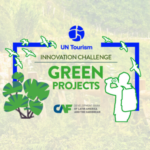
COVID-19 Pandemic has brought travelling to a standstill and tourism has been the worst affected sector. Travel agencies, Tour Operators, Transportation, Tour Guides, Hotels, Natural and Cultural Assets and many others tourism actors around the world are still trying to survive after 10 months with massively less production compared to last year.
According to UNWTO Global Guidelines, COVID-19 projected impact on tourism in 2020 are the following:
- International arrivals fell by 72% over the first ten months of 2020
- 1 billion fewer arrivals and a loss of some US$ 1.1 trillion in international tourism receipts
- An economic loss of US$ 2 trillion in world GDP.
Who will really end up emerging sustainably from the crisis in the tourism sector? At this stage of the crisis, I cannot accurately answer as there is not a single solution. I am very convinced that going back to the old model is no longer efficient and successful. For the future of tourism sustainability is key, since nobody wants to travel on a dead planet. Furthermore, Sustainable Travel is already being replaced by the Regenerative Travel concept, that means “leave it better than you found it”. To reach that goal each actor must play their role in order to Build Tourism Back Better.
Shifting to carbon neutrality is part of the solution:
Greenhouse gases (GHG) that occur naturally are essential for human survival because they prevent part of the sun’s heat from spreading into space, maintaining an average temperature on earth that makes our lives possible. But in the last 100 years, the amounts of greenhouse gases in the atmosphere, and in particular the carbon emissions that results from the burning of fossil fuels, has increased to levels never seen before – and as a result the average temperature of the planet is increasing fast.
In December 2019 the United Nations declared a climate emergency, pointing out the need of taking rapid and far-reaching actions to limit global warming current tendency.
The United Nations has been making crystal clear to all of us what we are already observing around the world. We see every day in the news information about the loss of glaciers, the increase in sea level to almost 1 meter, the increase of wildfires, the collapse of diverse-ecosystems and the loss of wildlife and biodiversity. All of which directly and indirectly affects our lifestyle, our social stability and naturally the tourism industry which relies very much on natural capital and security.
According to several studies, the international tourism shares of carbon emissions stand close to 8% of total carbon emissions. This fact highlights very much the responsibility of the tourism industry and the opportunity to engage in a positive climate action agenda which can contribute to Building Tourism Back Better.
An increasing number of companies are engaging in climate action. This is what is happening right now. The fact is that we are living now in a new business environment which is powered by people, people just like you and me and particularly by a new generation of millennials who are committed to embrace purpose and sustainability. Indeed, one recent report from Harvard University revealed that products with sustainability claims showed twice the growth of their traditional counterparts.
That means that there is a new profile of consumers. Markets which are concerned about the environment and climate have been growing, generating a new ecosystem of green businesses. A recent study carried out by Booking.com on precisely the growing trend and interest in products and responsible consumption showed that 86% of travelers want to travel more sustainably, but only half of them often or always manage to do so and 69% of travelers expect the travel industry to offer more sustainable travel options. And this definitely includes a positive response to climate change.
This growing trend requires companies in the tourism sector, destinations and the state to comply with new regulations and standards of sustainability and climate responsibility.
Even more, in a context such as today, where there is much discussion about the relation between the pandemic generated by COVID 19 and the degradation of ecosystems as a consequence of climate change. So, our common challenge in the tourism industry is to Build Tourism Back Better. We need to be part of the solution.
Based on our experience working with the tourism industry since 2010, we have been able to identify these three levels for climate action that can provide significant value added to destinations, companies and travelers.

At Macro or Destination Level, we should be able to commit tourism destinations to carbon neutrality, promoting private and public investments that are aligned with climate mitigation and adaptation challenges. This should be addressed through national and local authorities and work with the support of the private sector and communities. The Carbon Neutral tourism destination should be able to inspire people and businesses to innovate in products and services that allow them all to achieve concrete carbon reduction goals.
We are very proud to be working with the Government of Peru, the Municipality of Machu Picchu, AJE group, the Peruvian Society of Hotels and APTAE making Machu Picchu the first carbon neutral UNESCO Designated Site and the first carbon neutral tourism destination in Peru and possibly in the world.
As for the Companies’ level, we have been working in different regions supporting tourism companies to internalize climate actions and implement carbon mitigation and offsetting measures at corporate level. Tourism companies also have a strategic role to improve their climate performance within their value-chain. There are huge opportunities for carbon mitigation making value chains more climate friendly.
We have mentioned above about tourism destinations and travel companies internalizing climate action but as we said before, also the traveler can be involved in the process. There is a new profile of travelers that look not only for authentic experiences, but they also demand safety and sustainability.
You might be wondering how the final Travelers can do their part. They can be offered to offset their travel experience by planting trees and supporting biodiversity conservation in hotspots like Madre de Dios, in Peru through The Forest Friends Project. Green Initiative has a standard agreement formal that we use with companies that are willing to engage in this Project. We provide these companies with the necessary tools and training so that they can use our online platform, and we work together with them to the development of carbon neutral travel experiences. Our goal is to offset 10 million tons of carbon emissions by 2030.
And are you willing to join this movement? Don’t underestimate the power of small actions. Start contributing with your small grain of sand today and soon you will have internalized climate action and will be implementing a series of voluntary responses. There is no way out but a “Greener Reset” to emerge from the crisis. We will recover if we set the right expectations and keep looking forward, not backward. We have a great opportunity now to Build Tourism Back Better!
 Marcia Regis – Representative Director of the Green Initiative in Switzerland
Marcia Regis – Representative Director of the Green Initiative in Switzerland






